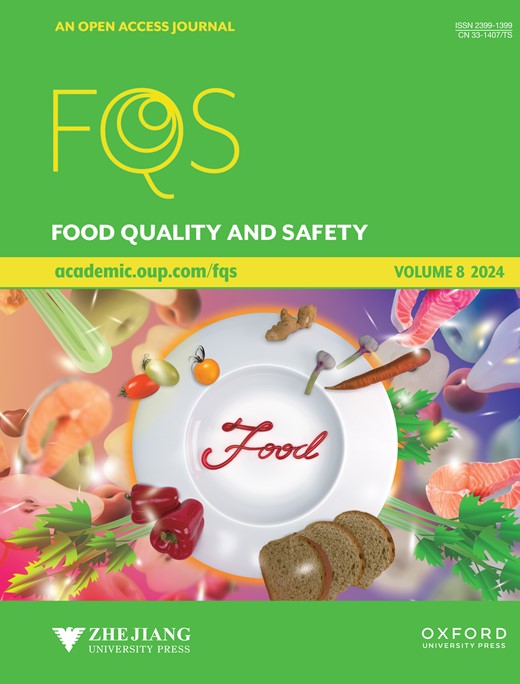Influence of stir-frying on the lipid stability and flavor substances in oat flour during storage using HS-SPME-GC-MS and electronic nose
IF 3
3区 农林科学
Q2 FOOD SCIENCE & TECHNOLOGY
引用次数: 0
Abstract
We used stir-fried oat flour as experimental material and raw oat flour as a control to explore the influence of stir-frying on the storage quality of oat flour. The HS-SPME-GC-MS method combined with the electronic nose technology was used to understand the lipid stability and analyze the changes in the flavor of the substances during the entire storage period. It was observed that during the storage period, stir-fried oat flour contained less water than raw oat. The former was characterized by a lower fatty acid value, lower acid value, and lower linoleic acid content, but higher oleic acid content and palmitic acid content compared to the latter. With the passage of storage time, the palmitic acid content significantly increased, and the linoleic acid content significantly decreased in raw and stir-fried oats flour (P <0.05). The sulfur and methyl contents in the stir-fried oat flour were higher than that in the raw flour, while the nitrogen oxide content in the former was lower than that in the latter. Stir-fried oat flour possessed a total of 78 identified flavor substances. The process of stir-frying boosts the oxidation decomposition of unsaturated fatty acids aldehydes and heterocyclic compounds produced by Maillard reaction, so that the flavor substances of stir-fried oat flour is richer. Stir-fried oat flour, containing diverse types of flavor substances, experienced more obvious flavor changes throughout the storage period than raw oat flour.利用HS-SPME-GC-MS和电子鼻研究了炒熟对燕麦粉贮藏过程中脂质稳定性和风味物质的影响
以翻炒燕麦粉为实验材料,以生燕麦粉为对照,探讨了翻炒对燕麦粉贮藏品质的影响。采用HS-SPME-GC-MS方法结合电子鼻技术来了解脂质的稳定性,并分析物质在整个储存期内的风味变化。观察到,在储存期间,炒燕麦粉比生燕麦含有更少的水。与后者相比,前者的特征是脂肪酸值较低、酸值较低和亚油酸含量较低,但油酸含量和棕榈酸含量较高。随着储存时间的推移,生燕麦粉和炒燕麦粉中棕榈酸含量显著增加,亚油酸含量显著降低(P<0.05)。炒燕麦粉的硫和甲基含量高于生燕麦粉,而氮氧化物含量低于生燕麦粉。炒燕麦粉共含有78种已鉴定的风味物质。翻炒过程促进了美拉德反应产生的不饱和脂肪酸醛类和杂环化合物的氧化分解,使翻炒燕麦粉的风味物质更加丰富。炒燕麦粉含有多种风味物质,在整个储存期内的风味变化比生燕麦粉更明显。
本文章由计算机程序翻译,如有差异,请以英文原文为准。
求助全文
约1分钟内获得全文
求助全文
来源期刊

Food Quality and Safety
FOOD SCIENCE & TECHNOLOGY-
CiteScore
7.20
自引率
1.80%
发文量
31
审稿时长
5 weeks
期刊介绍:
Food quality and safety are the main targets of investigation in food production. Therefore, reliable paths to detect, identify, quantify, characterize and monitor quality and safety issues occurring in food are of great interest.
Food Quality and Safety is an open access, international, peer-reviewed journal providing a platform to highlight emerging and innovative science and technology in the agro-food field, publishing up-to-date research in the areas of food quality and safety, food nutrition and human health. It promotes food and health equity which will consequently promote public health and combat diseases.
The journal is an effective channel of communication between food scientists, nutritionists, public health professionals, food producers, food marketers, policy makers, governmental and non-governmental agencies, and others concerned with the food safety, nutrition and public health dimensions.
The journal accepts original research articles, review papers, technical reports, case studies, conference reports, and book reviews articles.
 求助内容:
求助内容: 应助结果提醒方式:
应助结果提醒方式:


